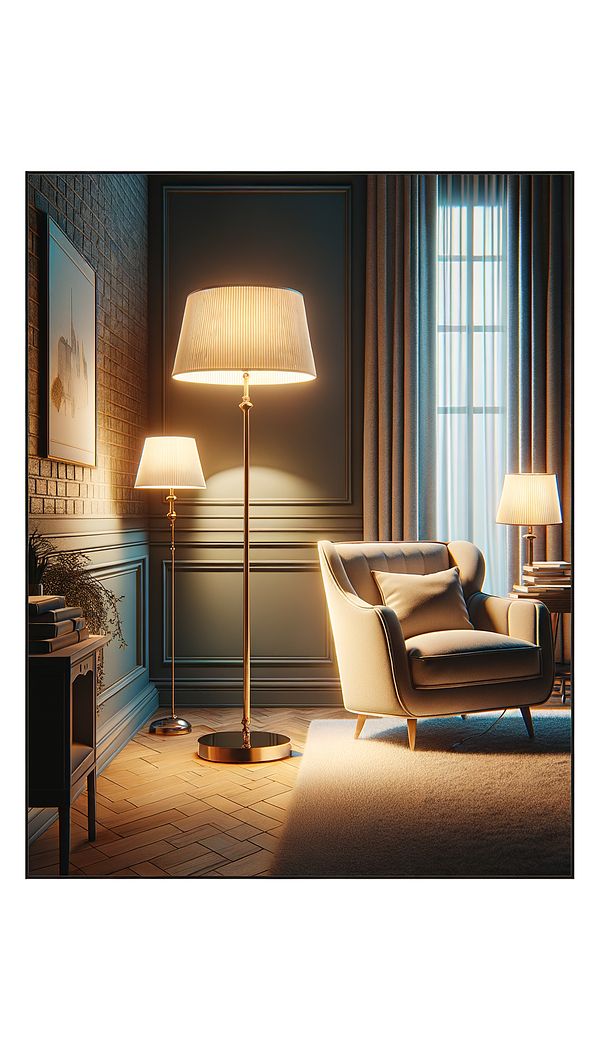What is a Floor Lamp?
A floor lamp is a tall, freestanding lighting fixture designed to stand on the floor.
Description
A floor lamp, in the realm of interior design, is much more than merely a source of illumination. It stands tall, not just in its physical form but as a piece that embodies both functionality and aesthetic appeal. Usually consisting of a base, a stem or body, and a light source at the top, floor lamps can feature a range of styles, materials, and finishes that cater to varying design needs and preferences.
Floor lamps offer versatility and convenience, functioning as task lighting, ambient lighting, or accent lighting depending on its design and placement within a space. Unlike fixed lighting, floor lamps can be easily moved to suit changes in layout or lighting needs, making them a favorite tool in the dynamic process of interior design. They are particularly useful in spaces lacking overhead lighting or where adding such fixtures would be impractical or too invasive.
The design of a floor lamp can significantly influence the ambiance of a room. With options ranging from sleek, minimalistic designs to intricate, ornate pieces, floor lamps can complement or contrast the prevailing design theme of a space. They can help redefine a room's focal points, adding depth and dimension to interior compositions.
Whether blending seamlessly into the background or standing out as a statement piece, the right floor lamp can enhance the mood, functionality, and visual appeal of a room. Its selection, therefore, requires careful consideration of both its practical and aesthetic aspects.
Usage
Floor lamps are commonly used in living rooms for creating a cozy reading corner or in bedrooms to provide soft ambient lighting. They are also seen in offices where direct lighting is required over a work area. Designers often utilize floor lamps to fill empty corners, add height to a space, or serve as a visual anchor in minimalist rooms.
FAQs
-
How tall should a floor lamp be?
The ideal height for a floor lamp depends on its intended use and the height of nearby furniture, but generally, they range between 58 to 64 inches tall to project light effectively across a space.
-
Can floor lamps be used in small spaces?
Yes, floor lamps can be beneficial in small spaces by providing adjustable lighting without taking up much space, especially slim or vertically-oriented designs that can light up corners or specific areas effectively.
-
How do I choose the right floor lamp for my room?
Consider the room’s function, existing décor style, and lighting needs. A lamp that complements the room's design while providing the right type of lighting (ambient, task, or accent) for the intended use is ideal.
Practical Application
When incorporating a floor lamp into your interior design, pay close attention to scale and proportion to ensure it complements the surrounding space and furniture. Adjust its placement to achieve the desired lighting effect, whether it's focusing light on a reading nook or casting a warm glow throughout the room. The lampshade's material and color can also hugely impact the quality and direction of light, making it an essential factor to consider.
-
Furniture Types599 articles
-
Lighting111 articles
-
Space Planning & Layout134 articles
-
Art & Sculpture30 articles
-
Decorating Principles & Elements330 articles
-
French RenaissanceFrench Renaissance refers to a period of rebirth in French art and architecture, emulating classical forms with a focus on symmetry and proportion.
-
FerruleA ferrule is a metal ring or cap used to strengthen or join objects.
-
Angel BedA decorative feature resembling a bed or rest area for angels.
-
PastelsPastels refer to soft, light colors used in interior design.
-
BowbackA design feature in chairs where the back consists of a curved piece of wood.
